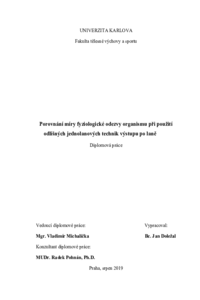Porovnání míry fyziologické odezvy organismu při použití odlišných jednolanových technik výstupu po laně
Comparison of human physiological response in different one-rope ascending techiques
diplomová práce (OBHÁJENO)

Zobrazit/
Trvalý odkaz
http://hdl.handle.net/20.500.11956/110349Identifikátory
SIS: 211776
Kolekce
- Kvalifikační práce [8709]
Autor
Vedoucí práce
Konzultant práce
Pohnán, Radek
Oponent práce
Baláš, Jiří
Fakulta / součást
Fakulta tělesné výchovy a sportu
Obor
Vojenská tělovýchova
Katedra / ústav / klinika
Vojenská tělovýchova
Datum obhajoby
16. 9. 2019
Nakladatel
Univerzita Karlova, Fakulta tělesné výchovy a sportuJazyk
Čeština
Známka
Velmi dobře
Klíčová slova (česky)
Vojenské lezení, zatížení organismu, srdeční frekvence, spotřeba kyslíku, subjektivní vnímání zátěže, prusíkování, blokanty, garda uzelKlíčová slova (anglicky)
Military climbing, load of organism, heart rate, oxygen consumption, rating of perceived exertion prusík knot, jümaring, garda knot body loadNázev: Porovnání míry fyziologické odezvy organismu při použití odlišných jednolanových technik výstupu po laně Cíle: Cílem této práce bylo porovnat míru fyziologické odezvy organismu při použití 3 odlišných jednolanových technik výstupu po laně při konstantní rychlosti. Metody: Jednalo se o empiricky založenou studii experimentálního charakteru - (kvaziexperiment). Výzkumný́ soubor (n=12) tvořil účelný výběr studentů (21±1,1 let; 183±4,9 cm; 80,6±7,8 kg) prezenčního studia Vojenského oboru při Fakultě tělesné výchovy a sportu Univerzity Karlovy (VO FTVS UK). Fyziologická odezva organismu při jednolanových technikách výstupu po laně ("prusíkování = P", "pomocí blokantů typu jümar = B", "pomocí uzlu garda = G") při konstantní rychlosti 3 m·min-1 po dobu 7 minut byla měřena pomocí přístroje Cortex Metamax 3b a sporttestru Polar. Dále bylo zaznamenáváno subjektivní vnímání zátěže do upravené Borgovy RPE škály. Data byla komparativně analyzována v programu SPSS statistic a pro statistické významnosti bylo využito metody opakované měření analýzy rozptylu (ANOVA). Výsledky: Bylo prokázáno, že existují statisticky významné rozdíly (p ≤ 0,05) mezi jednotlivými technikami. Nejjednodušší technika je B a největší rozdíly byly pozorovány mezi technikou B od P a G. Technika G se jevila jako nejobtížnější....
Title: Comparison of the physiological response rate of the organism using different one-rope ascent techniques Objectives: The aim of this study was to compare the rate of the physiological response of the organism using 3 different one-rope ascent techniques during constant speed. Methods: It was an empirically based study of experimental character (quasi-experiment). The measured research group (n = 12) consisted of the military students (21 ± 1.1 years; 183 ± 4.9 cm; 80.6 ± 7.8 kg) of full-time study at the Faculty of Physical Education and Sport of Charles University (VO FTVS UK). The physiological response rate was measured with the Cortex Metamax 3b and Polar sporttester during one-rope ascending techniques ("using Prusik knot" = P", "using jümar = B", "using Garda knot = G") at a constant speed of 3 m·min-1 for 7 minutes. The rating of the perceived exertion was also recorded on the Borg RPE scale. The data were comparatively analyzed in the SPSS statistic program, furthermore the analysis of variance (ANOVA) was also employed. Results: The study demonstrated statistical differences (p ≤ 0.05) between techniques: while B is the easiest, the greatest differences were observed between technique B, P and G. The G technigue appeared to be the most difficult. The average HR was: 162 ± 9 bpm...
